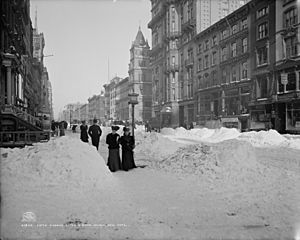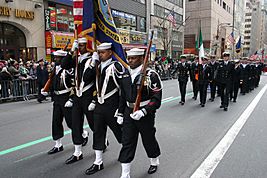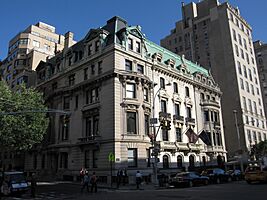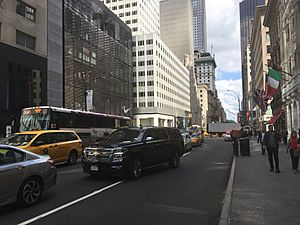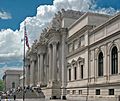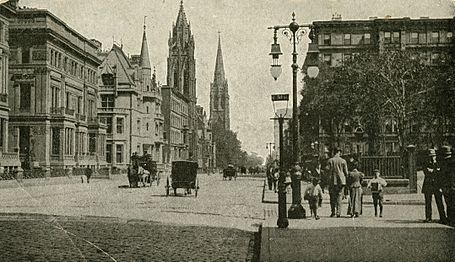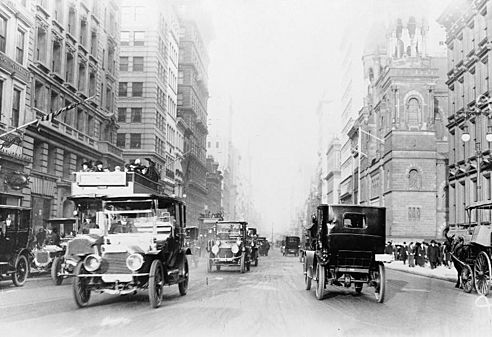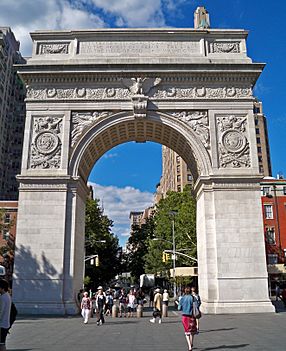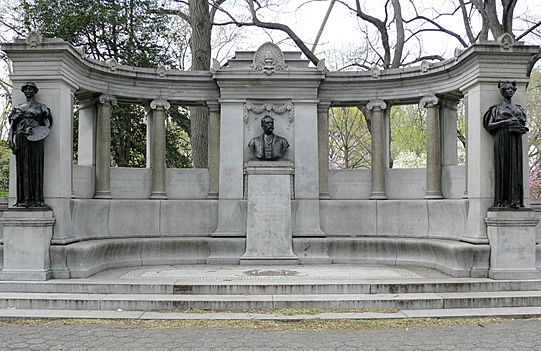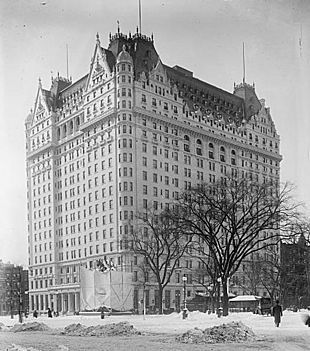Fifth Avenue facts for kids

Fifth Avenue in Midtown Manhattan
|
|
| Other name(s) | Museum Mile |
|---|---|
| Owner | City of New York |
| Maintained by | NYCDOT |
| Length | 6.197 mi (9.973 km) |
| Location | Manhattan, New York City |
| South end | Washington Square North in Greenwich Village |
| Major junctions |
Madison Square in Flatiron Grand Army Plaza in Midtown Duke Ellington Circle in East Harlem Marcus Garvey Park in Harlem Madison Avenue Bridge in Harlem |
| North end | |
| East | University Place (south of 14th) Broadway (14th to 23rd) Madison Avenue (north of 23rd) |
| West | Sixth Avenue (south of 59th) Central Park-East Drive (59th to 110th) Lenox Avenue (north of 110th) |
| Construction | |
| Commissioned | March 1811 |
Fifth Avenue is a very famous street in Manhattan, a part of New York City. It stretches from Washington Square Park in Greenwich Village all the way north to West 143rd Street in Harlem. This street is known as one of the most expensive shopping areas in the entire world!
Most of Fifth Avenue is a one-way street for traffic heading south. Before 1966, cars could drive both ways. A small part of the avenue, from 142nd to 135th Street, still has two-way traffic. Also, a section of Fifth Avenue is interrupted by Marcus Garvey Park. Southbound traffic has to go around the park.
Fifth Avenue is famous for its many exciting parades. Because of these events, the street is often closed to cars on Sundays. The part of Fifth Avenue south of Central Park was made wider in 1908 to handle more traffic.
The area between 34th and 59th Streets used to be mostly homes. But around the year 1900, it became a busy shopping area. The section of Fifth Avenue in the 50s is still one of the most expensive shopping streets anywhere.
The area between 59th and 96th Streets, next to Central Park, was called "Millionaire's Row" in the early 1900s. This was because so many rich people built huge mansions there. Another part of Fifth Avenue, from 82nd to 110th Streets, is known as Museum Mile. This is because it has many amazing museums.
Contents
History of Fifth Avenue
Early Beginnings
Fifth Avenue, especially the part between 42nd Street and Central Park South (59th Street), was not very developed in the late 1800s. This land was once part of New York City's common lands. The city gained control of these lands in 1686.
In 1785, the city council decided to sell off some of this land to make money. The land wasn't great for farming and was far from roads. So, they hired a surveyor named Casimir Goerck to divide the land into smaller plots. He also planned roads to reach these plots.
Goerck finished his first survey in December 1785. He created 140 plots and drew a street called Middle Road, which later became Fifth Avenue. The land was hilly, so people weren't very eager to buy the plots.
In 1794, as the city grew, the council hired Goerck again. He was asked to make the plots more even and rectangular. He also planned new roads to the west and east of Middle Road. These roads became Fourth and Sixth Avenues. Goerck's plans greatly influenced the famous Commissioners' Plan of 1811, which set up Manhattan's street grid.
Fifth Avenue in the 1800s
In the early 1800s, some wealthy people and important organizations started buying land on Fifth Avenue in Midtown. By the mid-1800s, several institutions were located there. These included orphanages and hospitals. Some areas even remained as cattle farms until the 1860s.
After the American Civil War, the Midtown part of Fifth Avenue became a fancy place to live. One of the first to build grand homes was Mary Mason Jones. She built "Marble Row" between 57th and 58th Streets around 1868-1870.
The famous Vanderbilt family also built three huge mansions along Fifth Avenue between 51st and 59th Streets in the late 1870s. By the 1880s and 1890s, the ten blocks of Fifth Avenue south of Central Park were known as "Vanderbilt Row."
When the Vanderbilts moved their homes uptown, many businesses on Fifth Avenue also started moving north. The upper part of Fifth Avenue, facing the new Central Park, wasn't developed as quickly. This was because there weren't many buildings on the other side of the park yet.
Fifth Avenue in the Early 1900s
The Midtown blocks of Fifth Avenue were mostly homes until the early 1900s. Then, they began to change into commercial areas. By 1900, there was so much traffic that people suggested limiting cars on the avenue.
Starting in 1908, the section south of Central Park was made wider. This meant making the sidewalks smaller to fit more cars. Buildings like the Waldorf–Astoria hotel had to trim their fronts. By 1911, the avenue was wider south of 47th Street. When widening continued north of 47th Street, many mansions were cut back or torn down. Even parts of St. Patrick's Cathedral had to be moved!
The first major commercial building on Fifth Avenue was built by Benjamin Altman in 1896. The B. Altman and Company Building opened between 1906 and 1914. This led to the creation of a high-end shopping district. Many fancy stores and fashionable women came to the area.
Other famous stores followed. The Lord & Taylor Building opened in 1914. The Saks Fifth Avenue Building opened in 1924. The Bergdorf Goodman Building opened in 1928-1929.
By the 1920s, Fifth Avenue was a very active place for new buildings in Midtown. Many office buildings were built, especially in 1926. This area became a major center for new development in Manhattan.
In the 1920s, special traffic towers helped control busy intersections on Fifth Avenue. These towers were first set up in 1920. They helped reduce travel time along the avenue. Later, in 1922, seven tall bronze traffic towers were added. These towers were designed by Joseph H. Freedlander. They were removed in 1929 because they got in the way of traffic. Newer, smaller bronze signals with statues of Mercury were then installed.
Fifth Avenue from Mid-1900s to Today
In 1954, with more traffic, there was a plan to allow only buses and taxis on Fifth Avenue. Then, on January 14, 1966, Fifth Avenue south of 135th Street became a one-way street, only for southbound traffic. Madison Avenue was changed to one-way northbound at the same time.
In the late 1960s and early 1970s, many fancy stores on Fifth Avenue's Midtown section either moved or closed. A survey in 1971 showed that less than 60% of the building fronts were still stores. The rest were banks or airline offices. The section between 34th and 42nd Street, once a main shopping area, was declining.
In 1971, New York City Mayor John Lindsay suggested a special rule to protect Fifth Avenue's shopping character. This rule required new buildings to have a certain amount of retail space. It also encouraged buildings with stores, offices, and apartments. This rule was approved in April 1971.
In 1998, a special crosswalk was added south of 50th Street. This was an experiment to help cars turn without bothering pedestrians. Another similar crosswalk was added near 49th Street. Both were removed in 2019.
In December 2022, for three Sundays, the city closed Fifth Avenue between 48th and 57th Streets to all cars. This was the first time this part of Fifth Avenue was closed to traffic (besides parades) since the 1970s.
Exploring Fifth Avenue
Fifth Avenue starts at Washington Square Park in Greenwich Village. It goes north through the center of Midtown Manhattan. It then runs along the east side of Central Park, marking the edge of the Upper East Side. Finally, it goes through Harlem and ends at the Harlem River at 142nd Street. Cars can cross the river on the Madison Avenue Bridge.
Fifth Avenue is important because it divides Manhattan into East and West streets. For example, it separates East 59th Street from West 59th Street. Avenues to the west of Fifth Avenue have higher numbers, like Sixth Avenue. Avenues to the east have lower numbers, like Third Avenue. Street addresses increase as you move away from Fifth Avenue.
The title "most expensive street in the world" for Fifth Avenue can change each year. This depends on money values and local economy. For many years in the 1990s, the shopping area between 49th and 57th Streets was the most expensive for retail space. In 2008, Forbes magazine called Fifth Avenue the most expensive street in the world. The fancy apartments at the top of buildings on Fifth Avenue are also very valuable.
The American Planning Association (APA) named Fifth Avenue one of the "2012 Great Places in America." This historic street has many famous museums, businesses, stores, parks, luxury apartments, and historical sites. These places show its long history and future vision.
Traffic and Parades on Fifth Avenue
Fifth Avenue has two-way traffic from 142nd Street to 135th Street. South of 135th Street, it is a one-way street for southbound traffic. This change happened on January 14, 1966. At the same time, Madison Avenue became one-way northbound. From 124th Street to 120th Street, Fifth Avenue is cut off by Marcus Garvey Park. Southbound traffic goes around the park.
Fifth Avenue is the traditional route for many big parades in New York City. This means it is closed to cars on many Sundays when the weather is warm. The oldest parade is the annual St. Patrick's Day Parade. These parades are different from the "ticker-tape parades" on Broadway or the Macy's Thanksgiving Day Parade. Fifth Avenue parades usually go from south to north. However, the LGBT Pride March goes north to south, ending in Greenwich Village.
Bicycling on Fifth Avenue
Bicycling on Fifth Avenue varies a lot. South of 23rd Street, there is a separate bike lane. Along Central Park, it's very scenic. But through Midtown, it can be dangerous with heavy traffic during busy hours. Most of Fifth Avenue does not have a special bike lane. A protected bike lane south of 23rd Street was added in 2017. Another protected lane for bikes going both ways between 110th and 120th Streets was announced in 2020.
In 1987, New York City Mayor Ed Koch suggested banning bikes on Fifth, Park, and Madison Avenues during weekdays. Many bicyclists protested, and the ban was stopped. A bike lane on Fifth Avenue between 59th and 42nd Streets was suggested in late 2022.
Public Transportation on Fifth Avenue
Bus Service
Fifth Avenue is one of the few main streets in Manhattan that never had streetcars. Instead, transportation was first provided by horse-drawn buses from 1885 to 1896. Then, the Fifth Avenue Coach company took over with motor buses. Double-decker buses ran until 1953 and again from 1976 to 1978.
In 1982, a special bus lane for Fifth Avenue in Midtown was announced. It opened in June 1983 and was only for buses on weekdays. In June 2020, Mayor Bill de Blasio said the city would try out busways on Fifth Avenue.
Today, local bus service on Fifth Avenue is provided by the MTA's M1, M2, M3, and M4 buses. The M5 and Q32 also use Fifth Avenue in Midtown. Many express buses from Brooklyn, the Bronx, and Staten Island also travel along Fifth Avenue.
Subway Stations
The New York City Subway has never built a line directly under Fifth Avenue. This is likely because wealthy residents might have objected. However, there are several subway stations on streets that cross Fifth Avenue:
- N, R, and W at Fifth Avenue–59th Street
- E and M at Fifth Avenue/53rd Street
- 7 <7> at Fifth Avenue and 42nd Street
- R and W at Fifth Avenue and 23rd Street
Famous Sections and Nicknames
Millionaire's Row: Upper Fifth Avenue
In the late 1800s, New York's richest people started building huge mansions along Fifth Avenue. This section was between 59th Street and 96th Street, facing Central Park. By the early 1900s, this area was known as "Millionaire's Row." It had grand homes like the Mrs. William B. Astor House.
A big change happened in 1916. The mansion at 72nd Street and Fifth Avenue was the first private home on Fifth Avenue above 59th Street to be torn down. It was replaced by a large apartment building. This started a trend.
In 1922, the city tried to stop the mansions from being replaced by apartment buildings. They limited the height of new buildings to about 75 feet. But an architect named J. E. R. Carpenter sued and won in 1923. He argued that fancy apartments would actually make the avenue look better. So, old mansions were quickly replaced with new apartment buildings.
This area now has many famous apartment buildings. Most were built in the 1920s. One unique building is the Solomon R. Guggenheim Museum between 88th and 89th Streets. It stands out from the other limestone buildings.
Museum Mile: A Cultural Journey

Museum Mile is the name for a section of Fifth Avenue from 82nd to 110th Streets. This area is sometimes called Upper Carnegie Hill. It's actually a bit longer than one mile (1.6 km). This "Mile" has one of the largest collections of cultural places in the world. Nine museums are located along this part of Fifth Avenue. A ninth museum, the Museum for African Art, joined in 2009. Its new building opened in late 2012.
The museums work together for the yearly Museum Mile Festival. This event helps promote the museums and get more people to visit. The festival usually happens on the second Tuesday in June, from 6 to 9 p.m. It started in 1979 to make people more aware of the museums and support the arts in New York City. During the festival, Fifth Avenue is closed to cars. All nine museums are free to enter that evening. Many museums offer outdoor art activities for kids, live music, and street performers.
Museums on the Mile include:
- 110th Street – The Africa Center
- 105th Street – El Museo del Barrio
- 103rd Street – Museum of the City of New York
- 92nd Street – The Jewish Museum
- 91st Street – Cooper Hewitt, Smithsonian Design Museum (part of the Smithsonian Institution)
- 89th Street – National Academy Museum and School of Fine Arts
- 88th Street – Solomon R. Guggenheim Museum
- 86th Street – Neue Galerie New York
- 82nd Street – The Metropolitan Museum of Art
Further south, at Fifth Avenue and 70th Street, you can find the Henry Clay Frick House. This building houses the Frick Collection.
Important Landmarks on Fifth Avenue
Fifth Avenue has many buildings with special landmark designations. These designations help protect their historical importance.
- The New York City Landmarks Preservation Commission (NYCL) identifies and protects city landmarks.
- The National Register of Historic Places (NRHP) is the U.S. government's official list of important historical sites.
- The National Historic Landmark (NHL) focuses on places of major importance in American history or culture. All NHL sites are also on the NRHP.
- World Heritage Sites are chosen by UNESCO for their global cultural or historical value.
Individual Landmarks You Can See
Here is a list of some famous historical sites on Fifth Avenue, from north to south:
| Name | Image | Address | Cross-street | NHL | NRHP | NYCL | Notes |
|---|---|---|---|---|---|---|---|
| 369th Regiment Armory |  |
2366 Fifth Avenue | 142nd–143rd Streets | Yes | exterior | ||
| St. Andrew's Church |  |
2067 Fifth Avenue | 127th Street | Yes | exterior | ||
| Harlem Fire Watchtower | 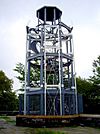 |
Marcus Garvey Park | 122nd Street | Yes | exterior | ||
| Central Park |  |
N/A | 60th–110th Streets | Yes | Yes | scenic landmark | |
| Museum of the City of New York |  |
1220–1227 Fifth Avenue | 103rd-104th Streets | exterior | |||
| Willard D. Straight House |  |
1130 Fifth Avenue | 94th Street | exterior | |||
| Felix M. Warburg House | 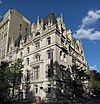 |
1109 Fifth Avenue | 92nd Street | Yes | exterior | ||
| Otto H. Kahn House | 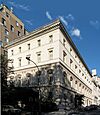 |
1100 Fifth Avenue (corner of) | 1 East 91st Street | exterior | |||
| Andrew Carnegie Mansion |  |
2 East 91st Street | 91st Street | Yes | exterior | ||
| Solomon R. Guggenheim Museum |  |
1009 Fifth Avenue | 82nd Street | Yes | Yes | exterior and interior | Also designated as WHS |
| Duke Residence |  |
1009 Fifth Avenue | 82nd Street | Yes | exterior | ||
| Metropolitan Museum of Art |  |
1000 Fifth Avenue | 80th–84th Streets | Yes | Yes | exterior and interior | |
| 998 Fifth Avenue |  |
998 Fifth Avenue | 81st Street | exterior | |||
| Harry F. Sinclair House |  |
2 East 79th Street | 79th Street | Yes | Yes | ||
| Payne Whitney House |  |
972 Fifth Avenue | 78th–79th Streets, midblock | exterior | |||
| James B. Duke House |  |
1 East 78th Street | 78th Street | Yes | exterior | ||
| Edward S. Harkness House |  |
1 East 75th Street | 75th Street | exterior | |||
| Henry Clay Frick House |  |
1 East 70th Street | 70th Street | Yes | Yes | exterior | |
| Robert Livingston Beeckman House | 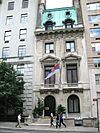 |
854 Fifth Avenue | 66th–67th Streets, midblock | exterior | |||
| Knickerbocker Club |  |
2 East 62nd Street | 62nd Street | exterior | |||
| The Metropolitan Club |  |
2 East 60th Street | 60th Street | exterior | |||
| Grand Army Plaza |  |
58th–60th Streets | scenic landmark | ||||
| The Sherry-Netherland Sidewalk Clock |  |
783 Fifth Avenue | 59th Street | Yes | |||
| Plaza Hotel | 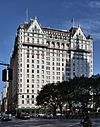 |
768 Fifth Avenue | 58th–59th Streets | Yes | Yes | exterior and interior | |
| Bergdorf Goodman |  |
754 Fifth Avenue | 57th–58th Streets | exterior | |||
| Coty Building |  |
714 Fifth Avenue | 55th–56th Streets, midblock | exterior | |||
| 712 Fifth Avenue | 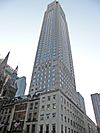 |
712 Fifth Avenue | 55th–56th Streets, midblock | exterior | |||
| The Peninsula New York |  |
696 Fifth Avenue | 55th Street | exterior | |||
| St. Regis New York |  |
693 Fifth Avenue | 55th Street | exterior | |||
| Aeolian Building | 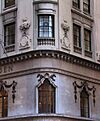 |
689 Fifth Avenue | 54th Street | exterior | |||
| University Club of New York | 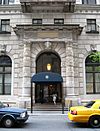 |
1 West 54th Street | 54th Street | exterior | |||
| Saint Thomas Church | 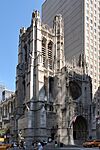 |
Corner | 1 West 53rd Street | exterior | |||
| Morton F. Plant & Edward Holbrook House |  |
653 Fifth Avenue | 52nd Street | Yes | exterior | ||
| George W. Vanderbilt Residence |  |
647 Fifth Avenue | 52nd Street | Yes | exterior | ||
| Rockefeller Center (including British Empire Building, La Maison Francaise, International Building) | 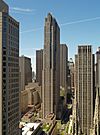 |
1–75 Rockefeller Plaza | 49th–51st Streets | Yes | Yes | complex | |
| St. Patrick's Cathedral |  |
460 Madison Avenue | 50th–51st Streets | Yes | Yes | exterior | |
| Saks Fifth Avenue Building | 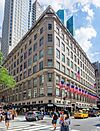 |
611 Fifth Avenue | 49th–50th Streets | exterior | |||
| Goelet (Swiss Center) Building |  |
608 Fifth Avenue | 49th–50th Streets | exterior and interior | |||
| Charles Scribner's Sons Building | 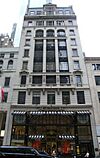 |
597 Fifth Avenue | 48th Street | exterior and interior | |||
| Fred F. French Building |  |
551 Fifth Avenue | 45th Street | Yes | exterior and interior | ||
| Sidewalk Clock, 522 Fifth Avenue | 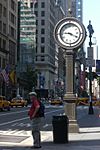 |
522 Fifth Avenue | 44th Street | Yes | object | ||
| Manufacturers Trust Company Building |  |
510 Fifth Avenue | 43rd Street | exterior and partial interior | |||
| 500 Fifth Avenue | 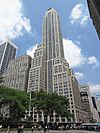 |
500 Fifth Avenue | 42nd Street | exterior | |||
| New York Public Library Main Branch |  |
476 Fifth Avenue | 40th–42nd Streets | Yes | Yes | exterior and partial interior | |
| Knox Building | 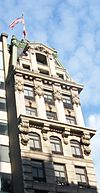 |
452 Fifth Avenue | 40th Street | Yes | exterior | ||
| Lord & Taylor Building | 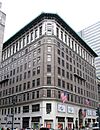 |
424 Fifth Avenue | 38th Street | exterior | |||
| Stewart & Company Building | 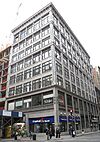 |
402 Fifth Avenue | 37th Street | exterior | |||
| Tiffany and Company Building |  |
401 Fifth Avenue | 37th Street | Yes | exterior | ||
| 390 Fifth Avenue | 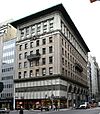 |
390 Fifth Avenue | 36th Street | exterior | |||
| B. Altman and Company Building |  |
355–371 Fifth Avenue | 34th–35th Streets | Yes | |||
| Empire State Building |  |
350 Fifth Avenue | 33rd–34th Streets | Yes | Yes | exterior and partial interior | |
| The Wilbraham | 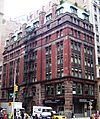 |
284 Fifth Avenue | 30th Street | Yes | exterior | ||
| Marble Collegiate Church |  |
272 Fifth Avenue | 29th Street | Yes | exterior | ||
| Sidewalk Clock, 200 Fifth Avenue |  |
200 Fifth Avenue | 24th Street | Yes | object | ||
| Flatiron Building |  |
173–185 Fifth Avenue | 22nd–23rd Streets | Yes | Yes | exterior | |
| Scribner Building |  |
153–157 Fifth Avenue | 21st–22nd Streets, midblock | Yes | exterior | ||
| Salmagundi Club | 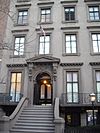 |
47 Fifth Avenue | 11th–12th Streets, midblock | Yes | exterior |
Historic Districts Along Fifth Avenue
Fifth Avenue also passes through several historic districts. These are areas with many important buildings. From north to south, they include:
- The Carnegie Hill Historic District: This city landmark district covers about 400 buildings. It's mainly along Fifth Avenue from 86th to 98th Street.
- The Metropolitan Museum Historic District: This city landmark district includes properties on Fifth Avenue between 79th and 86th Streets, near the Metropolitan Museum of Art.
- The Upper East Side Historic District: This is both a city and a national historic district. It runs from 59th to 78th Streets along Fifth Avenue.
- The Madison Square North Historic District: This city landmark district covers 96 buildings. It's around 25th to 29th Streets, near Broadway and Fifth Avenue.
- The Ladies' Mile Historic District: This city landmark district includes 440 buildings. It's roughly from 15th Street to 24th Street.
- The Greenwich Village Historic District: This city landmark district covers most of Greenwich Village. It includes almost all buildings on Fifth Avenue south of 12th Street.
In the 1980s, there was a plan for a historic district on Fifth Avenue between 48th and 58th Streets. Some buildings there were already landmarks, like St. Patrick's Cathedral. But others, like Rockefeller Center, did not have protection yet.
Economy and Shopping
Between 49th Street and 60th Street, Fifth Avenue is famous for its fancy shops and flagship stores. It is always ranked among the most expensive shopping streets in the world.
Many luxury brands, fashion designers, and sports companies have stores on Fifth Avenue. These include Louis Vuitton, Tiffany & Co. (whose main store is at 57th Street), Gucci, Prada, Armani, Tommy Hilfiger, Cartier, Omega, Chanel, Harry Winston, Salvatore Ferragamo, Nike, Escada, Rolex, Bvlgari, Emilio Pucci, Ermenegildo Zegna, Abercrombie & Fitch, Hollister Co., De Beers, Emanuel Ungaro, Gap, Versace, Lindt Chocolate Shop, Henri Bendel, NBA Store, Oxxford Clothes, Microsoft Store, Sephora, Tourneau, and Wempe.
Luxury department stores like Saks Fifth Avenue and Bergdorf Goodman are also on Fifth Avenue. You can also find an Apple Store there.
In the past, many airlines had ticket offices along Fifth Avenue. But by 1992, fewer airlines had offices there. Some airlines went out of business or moved their offices to other parts of Midtown.
Images for kids
-
The famous Metropolitan Museum of Art.
-
Fifth Avenue begins at the Washington Square Arch in Washington Square Park
-
The Plaza Hotel, c.1907
See also
 In Spanish: Quinta Avenida para niños
In Spanish: Quinta Avenida para niños



